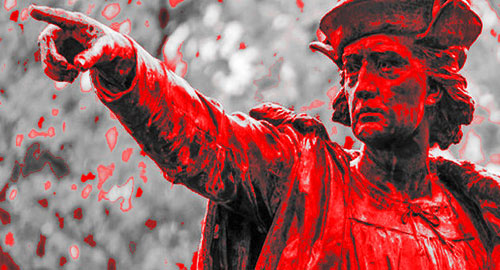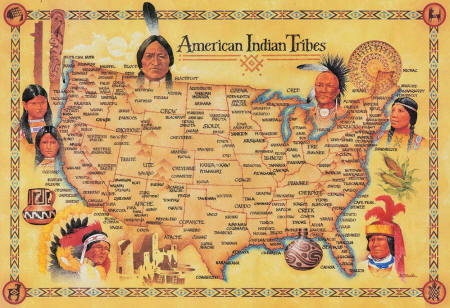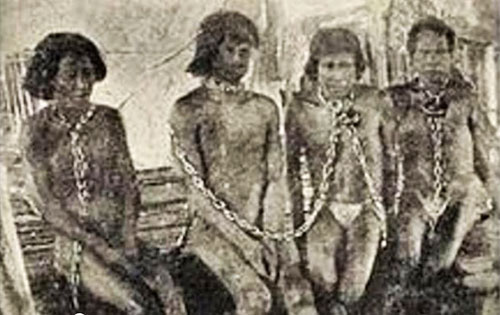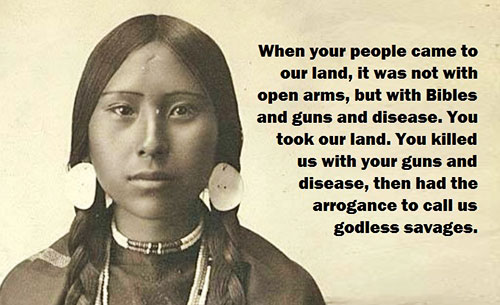|

by Irwin Ozborne
October 10, 2015
from
TakingTheMaskOff Website
Spanish version

"In 1492,
the natives discovered they were Indians,
discovered they lived in America, discovered
they were naked, discovered that the Sin
existed, discovered they owed allegiance to a
King and Kingdom from another world and a God
from another sky, and that this God had invented
the guilty and the dress, and had sent to be
burnt alive who worships the Sun the Moon the
Earth and the Rain that wets it."
Eduardo
Galeano
Los Hijos de los Días
- pag.198
A good friend of mine, a member of the
Republic of Lakotah, has a meeting
with her first grade son's elementary school principal. Apparently,
her six-year-old was being defiant in classroom.
What were these defiant actions?
Well, upon his teacher explaining
Columbus Day and honoring the
courageous and brave sailor who discovered this land in 1492, he had
a couple of questions for the teacher:
-
he wanted to know how it was
possible that he 'discovered' a land in which his ancestors
had lived for 30,000 years
-
he wanted to know what happened
to all the people who lived here in 1491
-
he wanted to know why the man
responsible for invading his native land and slaughtering
his ancestors was being honored
I would love to just be a fly on the
wall of that meeting with the elementary school principal.
Christopher
Columbus did NOT discover America
There, I said it...
The first thing we have been told about
in our early childhood is a complete fabrication of the truth. But,
that is only the beginning of the secret atrocities that shaped our
nation that we know today.
The Spanish Conquest of the Americas, preceded by Columbus's
"discovery" resulted in mass assimilation, raping, slaughtering,
enslaving, and intention to wipe out all evidence of more than 100
million indigenous people to the land.
These atrocities include:
-
Forced hard labor
-
Abducting and selling children
into the sex trade as young as nine-years-old
-
Mass raping of women and
children
-
Amputated limbs if you were not
producing enough
-
Buried alive or burnt alive if
you were resistant to the conquerors demands
-
Offering cash rewards for the
scalps of men, women, and children as proof of murder
-
Intentionally spreading smallpox
disease by means of biological warfare
-
Forced removal from homes and
land onto small reservations with unlivable circumstances
-
Death march of more than
one-thousand miles to these reservations, in which if you
were unable to continue the walk you were left for dead and
unable to assist dying family members
-
On these same reservations which
were "reserved" for the indigenous people, once this land
was deemed valuable, the agreement was broken and they are
forced to move once again. All 370 treaties signed between
the U.S. Government and Indian nations have been broken by
the United States
-
Public execution of those who do
not follow orders
-
Murdering children by slamming
against stone and tree trunks
-
Slicing open pregnant women's
stomach on public display as taunting those who do not
comply
-
Labeled as hostile savages if
not in complete compliance from the oppressor
-
These same mass murders become
labeled as heroes after sweeping through villages and
slaughtering unarmed civilians
-
Systematically kidnapping all
children and forcing them to a boarding school system in
which they are molested, beaten, forbidden to speak native
language and brainwashed into becoming "Americanized"
-
Not entitled citizenship in
their own land until 1924
-
Not included in the initial
civil rights act; did not receive equal rights until 1968
-
Not allowed to practice their
own religion until 1978
-
In the 1970's the attendance at
these brutal boarding schools peaked and it was not until
1975 that the United States Government emphasized reduction
in boarding schools with most of them finally closing in the
1980s and 1990s. In 2007, there were still 9.500 American
Indian children in boarding schools
-
Traditional lifestyle mocked and
ridiculed in mass media and in the classroom - socially
acceptable to discriminate against
-
Altered their history by
ignoring and denying the truth for the past four centuries.
These were the policies of our
government, the United States of America, and/or
the
Pope of the Catholic faith.
This wasn't done by aliens from outer
space. No, it was done by aliens from the East. Entered
illegally into an occupied land with force to subjugate and
exterminate the civilizations that had existed for 30,000 years.

A map of North
American Indian tribal territories
at the time of
Columbus' Arrival.
The American
Holocaust
Thousand-mile death march, concentration
camps, forced assimilation, mass killings by starvation/disease,
forced to change culture/beliefs…this all sounds familiar.
In John Toland's book "Adolf
Hitler - The Definitive Biography,"
he comments on the furor's admiration of the American Genocide:
Hitler's concept of concentration
camps as well as the practicality of genocide owed much, so he
claimed, to his studies of English and United States history.
He admired the camps for Boer
prisoners in South Africa and for the Indians in the Wild West;
and often praised to his inner circle the efficiency of
America's extermination - by starvation and uneven combat - of
the red savages who could not be tamed by captivity.
He was very interested in the way the Indian population had
rapidly declined due to epidemics and starvation when the United
States government forced them to live on the reservations. He
thought the American government's forced migrations of the
Indians over great distances to barren reservation land was a
deliberate policy of extermination.
Just how much Hitler took from the
American example of the destruction of the Indian nations is
hard to say; however, frightening parallels can be drawn.
For some time Hitler considered
deporting the Jews to a large 'reservation' in the Lubin area
where their numbers would be reduced through starvation and
disease.
But, that is kind of a harsh reality to
teach children in grade school.
So, we could probably soften it up a
little… or change it altogether.
Discover,
Invasion, or Conquer?
Discover is defined as finding something in the course of a search.
Invade is identified as an armed force
or its commander entering a country/region so as to subjugate or
occupy. Conquer means to overcome and take control of a place or
people by use of military force.
Discover technically could be applied as something was found, but
the problem is that something already had belonged to someone for
30,000 years. For perspective, it has only been 2,014 years since
Christ was 'born.'
That means the first indigenous people
reached the Americas 27,986 years ago; whereas Europeans have only
been here for 522 years.
The most interesting part about the definition of invade is the word
"subjugate" and the fact that Columbus used this exact word upon his
first encounter with
the Taino people:
"They… brought us parrots and balls
of cotton and spears and many other things, which they exchanged
for the glass beads and hawks' bells. They willingly traded
everything they owned…
They were well-built, with good
bodies and handsome features… They do not bear arms, and do not
know them, for I showed them a sword, they took it by the edge
and cut themselves out of ignorance.
They have no iron. Their spears are
made of cane… They would make fine servants… With fifty men we
could subjugate them all and make them do whatever we want."
"With fifty men we could SUBJUGATE
them and do whatever we want."
Interestingly enough the term subjugate
is defined as bringing under domination or control, especially by
conquest.
Conquest is simply the act of conquering, which is interlocked with
our final term. It is indisputable that the place and people were
taken control of by military force. In fact, the exact term in
history is labeled, "The Spanish Conquest."
Clearly, Columbus's voyage may have initially been a "discovery,"
but upon his first impression of the people of this island it
quickly turned to an "invasion." Following his death, Hernán
Cortés and Francisco Pizarro carried out the tasks of
conquering the Americas.
Now, before you disregard this article as a wacky conspiracist
nut, anti-American post, please understand that this is more
about seeking the other side of the story.
It is about viewing the landing of
Columbus's ships on May 12, 1492, from the occupants of that land -
the Taino and Arawaks perspective.

Columbus Early
Life
Born as Cristofor Colombo (Italian name; Spanish: Cristóbal
Colón; Portuguese: Cristóvão Colombo; and American: Christopher
Columbus) was born in Genoa, Italy, in 1451.
He grew up working on ships and began
sailing at age 10. Upon delivering goods to northern Europe in 1476,
upon his return his ship was burnt by a group of French sailors and
he swam to shore in Portugal.
He remained in Portugal and started
working for the kingdom, which had the finest fleet in the world at
this time.
During the middle ages, the kingdoms of Europe made their wealth by
trading with Asia. But in 1453, the Turkish Empire cut off all land
routes and the race to find a sea route to Asia had begun. Columbus
sailed along the coasts of Africa, trading with the colonies and
learning of the currents and wind patterns of the Atlantic.
In 1487, a different Portuguese sailor,
Bartholomeu Dias made his way around the southern tip of
Africa and discovered the eastern coast; giving strong belief to a
quicker route to Asia by sea.
Columbus had already believed the world was smaller than that of the
common-held belief of this time. Once Dias' made this discovery,
Columbus's desire to sail west intensified as he had been seeking
sponsorship for a trip across the Atlantic as early as 1484.
NOTE:
Nobody in the 15th century
believed that the world was flat.
This is an outright lie by the
American school system. The Greek philosopher Pythagoras first made
this theory nearly 7,500 years before Columbus was born. Aristotle,
4th century B.C., added more proof by observing the stars.
As historian Jeffrey Russel
Burton states,
"With extraordinary few
exceptions, no educated person in the history of Western
Civilization from the third century B.C. onward believed that
the Earth was flat."
Columbus was rejected funding from Portugal, twice by Italy, Spain,
England, and France.
However, upon the Spanish kingdom
conquering Granada they were more willing to fund his voyage of
three ships and 80 men. Struggling to find a crew, Queen Isabella
released prisoners early to join the voyage along with other
criminals, conquistadors, and pig farmers.
Also, following Spain's capture of
Granada, there were some unemployed military men that were sent
along on Columbus's voyage. For it was these men that did not fear
dying at sea, as it was for more appealing than what life had in
store for them in Spain.
And in August of 1492, after eight years
of trying to make a voyage around the world, Columbus set sail
seeking the riches of Asia.
First Voyage
The first voyage to the so-called "new world" was highly
unsuccessful, despite the credit and admiration it has received.
After weeks at sea and a disgruntled
crew of men, Columbus gave an ultimatum of finding land in the next
two days or head back to Spain - dated October 10, 1492.
As unfortunate fate would have it, two
days later Rodrigo de Triana was the first to spot an island,
which is modern day Dominican Republic.
However, with a large payout at stake,
Columbus claimed that he actually spotted the light the night before
- hence, claiming the lifetime pension from King Ferdinand
and Queen Isabella of Spain.
Columbus claimed the land for Spain and renamed it San Salvador
although it had been occupied for thousands of years by the
Taino,
Arawak, and
Lucayans (all extremely hospitable per many written accounts).
Early estimates believe there were up to
three million indigenous people living in the Caribbean; whereas
more recent studies believe that number to be closer to eight
million.
As written in his journals upon his first encounter with the Taino:
"These people have no religious
beliefs, nor are they idolaters. They are very gentle and do not
know what evil is; nor do they kill others, nor steal; and they
are without weapons."
Columbus quickly captured a handful of
Taino to help guide him to find gold, while putting many into forced
labor and sent thousands back to Spain to be sold as slaves
(although most of them died on the journey back across the
Atlantic).
"As soon as I arrived in the Indies,
in the first island which I found, I took some of the natives by
force, in order that they might learn and might give me
information of whatever there is in these parts. And so it was
that they soon understood us, and we them, either by speech or
by signs, and they have been very serviceable."
Merry
Christmas - 1492 Style
After a few weeks exploring around Cuba, Columbus made his way back
toward Hispaniola (Dominican Republic).
On Christmas Eve, the Santa Maria
shipwrecked before making it to land. The Arawak Indians saw the men
struggling and their chief ordered all his men to swim out to sea
and help the settlers to safety - including the chief himself.
The Arawak invited the settlers into their home.
Columbus wrote of the kind hospitality
of the Arawaks:
"They are artless and generous with
what they have, to such a degree as no one would believe but him
who had seen it. Of anything they have, if it be asked for, they
never say no, but do rather invite the person to accept it, and
show as much lovingness as though they would give their hears."
With not enough room on the two
remaining ships, Columbus left 39 men behind to settle a fort in
which he called La Navidad.
When Columbus returned to Spain, his stories of the new world
impressed the King and Queen - mostly due to his large exaggerations
of the amount of gold present in the Caribbean.
The Spanish royalty granted him another
voyage, but this time with 17 ships, 1200 men, livestock, and
weapons.
Columbus consistently wrote about the kindness of the people that he
encountered on his first voyage and shared this with the Kingdom of
Spain:
"They are so naive and so free with
their possessions that no one who has not witnessed them would
believe it. When you ask for something they have, they never say
no. To the contrary, they offer to share with anyone…"
Catholic
Conquest
On May 4, 1493, the beginning of the Spanish Conquest took place
with
the approval of Pope Alexander VI.
The Pope stated that any land not
inhabited by Christians was available to be "discovered," claimed
and exploited by Christian rulers and declared that,
"the Catholic faith and the
Christian religion be exalted and be everywhere increased and
spread, that the health of the souls be cared for and barbarous
nations overthrown and brought to faith itself."
This became known as the "Doctrine of
Discovery" and became the basis for all European claims in the
Americas and continued with the United States western expansion in
the 1800's.
As a United States Supreme Court case in
1823 states that,
"the principle of discover gave
European nations an absolute right to New World lands."
Basically stating the American Indians
had no right to their land. And, it was not until 1924 in which
"Native Americans" were allowed citizenship.
I quote the term Native
Americans to highlight the irony of not being granted citizenship to
their homeland until 450 years after the Europeans tried to wipe out
their civilization.
Following his first voyage, Pope Alexander VI granted the new world
to King Ferdinand and Queen Isabella, claiming:
"We of our own motion, and not at
your solicitation, do give, concede, and assign for ever to you
and your successors, all the islands, and main lands,
discovered; and which may hereafter, be discovered, towards the
west and south; whether they be situated towards India, or
towards any other part whatsoever, and give you absolute power
in them."
Later, as word of the mistreatment of
the natives reached the Spanish Kingdom, Queen Isabella finally made
a "Stand."
She proclaimed that the Natives shall be
given the opportunity of converting to Catholicism before being
forced into slavery.
But, claiming slaves of anyone non-Christian was not a new trade.
Back in 1455, the Pope issued a statement allowing Portugal to
enslave any non-Christians. Columbus got started in his slave
trading back in 1480's as he sailed along the West coast of Africa
picking up slaves for the Portuguese kingdom.
And on his third voyage, Columbus was the first to bring African
slaves to the new world in the Dominican Republic (Hispaniola) with
his claim that "one African slave is equal to four Indians."
By 1514, the Spanish Conquistadors carried with them an ultimatum
entitled, "The Requirement," in which the Indians were forced to
accept,
"the Church as the Ruler and
Superior of the whole world."
The Requirement warned the
natives the consequences for non-compliance:
"We shall take you and your wives
and your children, and shall make slaves of them, and as such
shall sell and dispose of them as their Highnesses may command;
and we shall take away your goods, and shall do all the harm and
damage that we can."
Second Voyage
The King and Queen of Spain were eager to fund a second voyage
following Columbus's reports of the first trip to the new world. In
his largely exaggerated accounts he shared:
"Hispaniola is a miracle. Mountains
and hills, plains and pastures, are both fertile and beautiful…
the harbors are unbelievably good and there are many wide rivers
of which the majority contain gold... There are many spices, and
great mines of gold and other metals…"
Columbus returned in 1493 to find the
fort at La Navidad burnt to the ground and all 39 men were killed.
It was reported that these men
apparently had "Misbehaved." And, of course, by misbehave it is
meant they raped all the women and children and tried to steal
whatever they could get hands on. In hindsight, leaving 39 released
criminals into a land with no rules and laws it should not have
surprised Columbus.
The Spaniards retaliated and Columbus forced anyone age 14 or older
to work in the mine fields daily searching for gold.
If they refused, they were killed. If
they did not meet quotas each month - they had hands and arms
amputated. Many began committing suicide to avoid the tortures of
the Spaniards, while others were buried alive for refusing to oblige
to Columbus. The Taino were being killed by starvation, worked to
death, disease, or murder. The women were all given to the Spaniards
to do as they chose.
Columbus wrote of the innocence of the Natives and his intent to
sell them into the slave trade:
"Naked as the day they were born,
they show no more embarrassment than animals."
Columbus later wrote:
"Let us in the name of the Holy
Trinity go on sending all the slaves that can be sold."
With not enough gold to return to Spain,
Columbus rounded up the best one-thousand Taino he could find.
He gave half to the Spanish colonists
and took the other half to be sold to the slave trade in Spain.
While 250 of the 500 died en route back to Spain, the conquistadors
simply tossed them overboard.
With much disorder among the colonists
at this time, Columbus left his brothers in charge of the islands as
he returned to Spain.
Third Voyage
Upon his return, the island was in more disarray than when he left.
Columbus embarked on daily beatings,
raping, feeding infants to wild animals, and progressing the sex
trade of children. Columbus began selling girls as young as nine
years old into the sex trade as accounted in his writings:
"A hundred castellanoes are as
easily obtained for a woman as for a farm, and it is very
general and there are plenty of dealers who go about looking for
girls; those from nine to ten are now in demand."
As word got back to Spain, the King and
Queen had Columbus and his brothers arrested and shipped back to
Spain.
At the same time, a man named
Bartolomé De Las Casas was aboard the third voyage with Columbus
and was the first to speak out about the crimes against humanity in
the new world.
While settling into Hispaniola in hopes of fortune in the new world,
La Casas was a slave owner himself until 1509 in which he started
speaking out against the crime. However, he still believed in
converting those to Christianity but in a peaceful, non-violent way.
While it was applauded by the royalty of
Spain, it was simply not followed by the Conquistadors.
La Casas wrote of these atrocities:
"Endless testimonies... prove the
mild and pacific temperament of the natives… But our work was to
exasperate, ravage, kill, mangle and destroy…
And the Christians, with their horses and swords and pikes began
to carry out massacres and strange cruelties against them.
They attacked the towns and spared
neither the children nor the aged nor pregnant women nor women
in childbed, not only stabbing them and dismembering them but
cutting them to pieces as if dealing with sheep in the slaughter
house.
They laid bets as to who, with one
stroke of the sword, could split a man in two or could cut off
his head or spill out his entrails with a single stroke of the
pike.
They took infants from their
mothers' breasts, snatching them by the legs and pitching them
head first against the crags or snatched them by the arms and
threw them into the rivers, roaring with laughter and saying as
the babies fell into the water, 'Boil there, you offspring of
the devil!'."
Forgotten
Parts of the Legacy
Columbus was arrested, shipped back to Spain and stripped of all his
land and titles of "discoverer."
However, he did find a way to be
released and allowed to explore once again - with gold! He presented
gold to the King and Queen and was pardoned and allowed a fourth
voyage.
He passed away in 1506 always believing he had landed in Asia and no
knowledge this was an entirely different continent.
During the ten years of his four voyages
(1492-1502) the population decreased from 3-8 million inhabitants to
less than 50,000. By the mid 1500's that number was reduced to just
500 remaining Taino.
A liar, crook, thief, rapist, pedophile, savage, torturer, genocidal
murder, introducer of slave and sex trades, and conqueror did not
discover anything besides a beautiful group of people who rescued
him and welcomed him into their home.
The thirst for wealth, greed, and power wiped
out generations within a decade. And for his "bravery"; we celebrate
the day he invaded the land of the people that rescued him.
Enjoy your paid day off...

|





